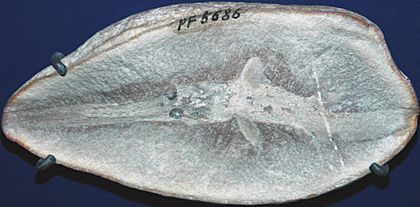Mazon Creek fossil beds facts for kids
Quick facts for kids Mazon Creek fossil bedsStratigraphic range: ~309–307Ma |
|---|
|
Mazon Creek Fossil Beds
|
|
| Lua error in Module:Location_map at line 420: attempt to index field 'wikibase' (a nil value). | |
| Nearest city | Benson Road, Morris, Illinois |
|---|---|
| NRHP reference No. | 97001272 |
| Significant dates | |
| Added to NRHP | September 25, 1997 |
| Designated NHL | September 25, 1997 |

The Mazon Creek fossil beds are a very special place near Morris, Illinois in Grundy County, Illinois. It's known as a lagerstätte, which is a German word meaning a "storage place" where many amazing fossils are found. These fossils are kept safe inside hard, round rocks called ironstone concretions.
These fossils are super old, about 309 million years old! They formed during a time called the mid-Pennsylvanian epoch, which was part of the Carboniferous period. What makes Mazon Creek so special is that these rocks often preserve not just hard parts like bones, but also soft parts of animals and plants. Many soft-bodied creatures, which usually don't turn into fossils, are found here.
People have known about the amazing fossils in this area since the mid-1800s. Because there are so many different kinds of fossils, and they are so well-preserved, the Mazon Creek lagerstätte is very important to paleontologists. They study these fossils to understand what life was like in this ancient environment. In 1997, this special place was even named a National Historic Landmark.
Contents
How Mazon Creek Fossils Formed
The Mazon Creek fossils are found in a type of rock called the Francis Creek Shale. This rock formed about 309 million years ago during the Pennsylvanian period. The area was once a huge river delta system, like where a big river meets the ocean. The climate was tropical, similar to today's rainforests, because this land was close to the equator.
When plants and animals died, they were quickly covered by mud and sand carried by the river. This quick burial helped protect them. Tiny bacteria then started to break down the remains. This process released carbon dioxide gas. This gas mixed with iron that was dissolved in the groundwater. This created a mineral called siderite around the dead plants and animals.
Over time, this siderite hardened into tough, protective balls of ironstone around the fossils. This special way of forming fossils is called authigenic mineralisation. It's why the fossils are so detailed and well-preserved inside their rocky cocoons.
Where to Find Mazon Creek Fossils
You can find these fossil-filled rocks in the Mazon River area, across several counties in Illinois, including Grundy, Will, Kankakee, and Livingston. You might also find them in LaSalle County, Illinois.
These ironstone concretions are often found along streams, in places where roads have been cut through the land, or in areas where coal mining used to happen. Many fossils come from old mining sites.
One famous area is what used to be called "Pit 11," which was a large strip mine. This area is now the Braidwood State Fish and Wildlife Area, an Illinois state park. If you want to look for fossils there, you usually need a permit.
The fossils found in the northern mining pits (like Pits 1-8) are known as the Braidwood Biota. These are mostly fossils of land plants and animals, and creatures that lived in freshwater. Pit 11, on the other hand, is famous for its Essex Biota, which has many more marine (sea) creatures.
Mazon Creek Plant Life
The Mazon Creek area has fossils from over 400 different types of plants! It can be tricky to count them exactly because paleobotanists (scientists who study ancient plants) sometimes give different names to different parts of the same plant, like a leaf or a stem.
Some of the cool plants found here include:
- Clubmosses: These are related to modern club mosses. Some were huge trees, like Lepidophloios and Sigillaria. Others were smaller, like Lycopodites.
- Horsetail Relatives: Plants like Calamites looked like giant horsetails.
- Ferns: There were many kinds of ferns, including tree ferns and smaller ferns that grew on the forest floor.
- Seed Ferns: These are an extinct group of plants that looked like ferns but reproduced using seeds instead of spores. They grew as both trees and shrubs.
- Conifer Relatives: Cordaites was an ancient tree that shared many features with modern conifer trees, like pines and spruces.
Mazon Creek Animal Life
Scientists have identified over 320 different kinds of animals from Mazon Creek! As mentioned before, these animals are divided into two main groups based on where they lived: the Essex fauna (marine animals) and the Braidwood fauna (land and freshwater animals). They were all washed into the river delta and buried.
Essex Biota: Marine Animals
The Essex fauna includes creatures that lived in the ocean. Some common finds are:
- Jellyfish
- Sea worms
- Snails
- Saltwater clams
- Shrimp
- Sea scorpions
- Cephalopods (like ancient squid)
- Fish
The most common fossil found in the Essex area is a type of jellyfish called Essexella. It makes up 42% of all the fossils found there! The Essex area is also home to Illinois' state fossil, the famous Tullimonstrum, often called the "Tully Monster." Other interesting marine creatures include the crustacean Belotelson.
Braidwood Biota: Land and Freshwater Animals
The Braidwood fauna includes animals that lived on land or in freshwater. These include:
- Insects
- Millipedes
- Centipedes
- Scorpions
- Spiders and other arachnids
- Amphibians
- Freshwater fish
- Freshwater shrimps
- Freshwater horseshoe crabs
Scientists have even found the oldest known beetle fossil in the Braidwood fauna!
Centipede fossils are very rare, but Mazon Creek has given us three different species:
- Latzelia primordialis
- Mazoscolopendra richardsoni
- Palenarthrus impressus
Mazoscolopendra and Palenarthrus are the only known fossils of a group of centipedes called scolopendromorphs from the ancient Paleozoic era.


